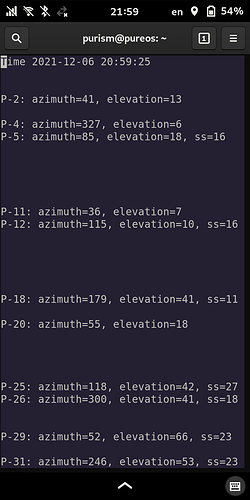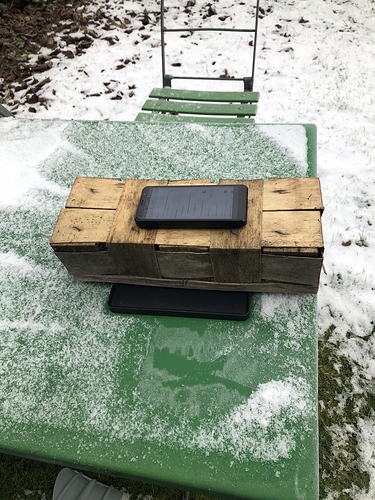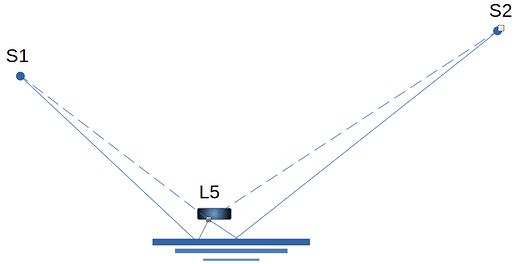Thanks. I run it and it shows the above screen. Will it show a fix?
yes, second line if a fix is there.the china position (which has no fix=true) will not be shown. you see the ss values are above 20 for 3 satellites - that’s by far better than with my device. i would guess it could get a fix inbetween 20min or so.
my script does not save the almanac & ephimeris data, so the tff will be again 20min next time.
I don’t think “inside” is viable, although it might depend on the construction of your house.
20 minutes outside should be enough to download the needed data for the initial fix. (Wikipedia says 12½ minutes but that might be in ideal conditions so 20 minutes allows a margin.)
Once the almanac data and ephemeris data are downloaded by and stored on the GNSS chip, going outside again should lead to getting a fix in under a minute. Maybe 20 to 30 seconds.
i live in a roof flat with roof windows - there is a window pane only between l5 and sky. should not be a problem. visibility is good, not much is covered by the roof itself. point is: i have power inside and can keep the phone running for hours.
nevertheless i tried it outside (but not so long) with exactly the same behaviour.
I did tests with the phone display down and display up. The results are amazing:
tests with:
sudo guru/gnss_test.py
1. test
date: Di. 7 Dez. 2021 10:26:58 CET
conditions: cloudy, a bit snowing, L5 display down on table, table 2cm snow
TTFF: 9.4 secs
GPS 0.3
--------------------------------------
longitude xx.62258417
latitude xx.05257883
altitude (m) 574.87
accuracy 2.5
fix 3D
View sats
S09:41.0 S07:32.0 S06:36.0 S30:34.0 S02:35.0 S20:33.0 S04:17.0
Solution sats
S09:41.0 S07:32.0 S06:36.0 S02:35.0 S20:33.0
timestamp 2021-12-07 09:27:47.05
Fix time 1638865667.000
TTFF 9.4
===========================================================================
2. test
Di. 7 Dez. 2021 10:37:44 CET
conditions: cloudy, a bit snowing, L5 display up on table, table 2cm snow
TTFF: none
no satellites seen after 10 minutes
===========================================================================
3. test
Di. 7 Dez. 2021 10:46:15 CET
conditions: cloudy, a bit snowing, L5 display down on table, table 2cm snow
TTFF: 7.6 secs
GPS 0.3
--------------------------------------
longitude xx.62252017
latitude xx.05258783
altitude (m) 588.48
accuracy 2.5
fix 3D
View sats
S20:35.0 S30:37.0 S05:33.0 S07:29.0 S02:33.0 S06:33.0
Solution sats
S20:35.0 S30:37.0 S07:29.0 S02:33.0 S06:33.0
timestamp 2021-12-07 09:45:41.13
Fix time 1638866741.000
TTFF 7.6
It looks like the antenna is shielded by something (electronics?). Can you repeat this experiment as follows:
- metal plate (~twice the size of the phone) on the table
- the cardboard basket from earlier experiment on top (~10cm high)
- L5 up on top of the basket
If this gives good results: still doubtful antenna connection. Ground plate reflection provides antenna gain (snow may have the same effect)
I did so. See photo. Btw: the basket is made of thin wood, if this does any matter. With display in direction sky no satellite visible at all. WIth display down, a 3D fix within ~68 secs:
...
fix 3D
View sats
S06:26.0 S11:22.0 S19:26.0 S09:27.0 S02:29.0 S20:23.0
Solution sats
S06:26.0 S19:26.0 S09:27.0 S02:29.0 S20:23.0
timestamp 2021-12-08 08:15:19.26
Fix time 1638947719.000
TTFF 67.8
I did the same yesterday on top of my car. Display down gets a fast fix.
Does this mean that the antenna of the GNSS chip is located wrong in the device?
I have generally been outside holding the phone so that I can read the screen i.e. neither directly down nor directly up (but probably more up than down).
PS What’s all that white stuff all over the place? 
it proves that it’s a good idea to have a heating device in your pocket. that’s why purism doesnt solve the power consumption problem until spring! ![]()
Yes, possibly enforced by bad connection (earth). With a good connection the signal should be enough in almost every direction.
The picture shows the possible ground reflection when the L5 is about 10cm above surface. This could clarify the good reception when “up” about 1/2 lambda (~10cm) above earth. But I expected this good reception also with a metal plate. (what is the black thing under the basket? It changes the distance. In the Ghz frequencies distance between antenna and reflector is very sensitive ).
This black thing is a metal plate of 20x20cm (as you said I should put below the basket), material is perhaps iron with Teflon cover (some plate from a grill). Should I test something else or bigger?
It should be a bigger area, I forgot the distance. Think of 1m x 1m. You can use aluminum folio or similar metallic cover with good conductivity. It’s a bit like the reflector of a yagi antenna without directors. (or a satellite disk with infinite radius).
By the way it should not be like this. In good condition the GPS antenna should function in almost all directions by directly (not indirectly due to reflection) receiving the satellite signals. The 10cm box was just a lucky accident (unless you deliberately choose this distance based on knowledge of the GPS frequency)
Thanks, I will do it the other day, it’s snowing today here. The basket was just taken by accident because I didn’t wanted to put the L5 on the earth. And also by accident it is exactly 10cm high.
Interestingly enough, after upgrading gnss-share (and then removing it and reverting back to the python version) my gps does not work anymore.
grep -a ‘GSV’ /dev/gnss0
returns nothing even in clear sky after a couple of hours. Starting gnss-share and pure-maps I never get a fix, and running gpsd and xgps (which used to display the available satellites) reports nothing.
cat /dev/gnss0
returns something, so the gps chip seems to be working, no idea what could have happened. Anybody?
do you really mean “nothing” or lines without the expceted ‘ss’ value?
i doubt this behaviour is related to removing/installing software.
here it takes 500-600 lines before it starts to send $GPGSV, (which is 80sec considering 7 lines every second).
Literally nothing. No results for hours. I also tried the gnss_test.py script posted here. lon, lat and altitute are printed, accuracy is 99, fix is None and view sats is always empty even after many hours.
Yeah, maybe gnss-share sent some command to the gps chip and disabled something (which is not restored after a reboot?). No idea, but since nothing else changed (e.g., the phone has not dropped in the meanwhile) I see no other reason for this
Have you only re-booted or power-off and re-start?
no, it only sends a reset on start but that is done (as i understand a posting about the module) on opening /dev/gnss0 as well.
but it sends the almanac&ephimeris data to the module which makes a difference. after doing so my device “saw” a different set of satelites for a while (with no ss).
i wrote an email to support@puri.sm to make them aware of the problem. maybe others could write their findings about it as well?
I think, all the findings and experiments are written here in this forum thread. The techies of support should just reading it and carry out the same (or better) investigations. I’ll later the day write to support@ and point them to this here, to make sure they haven’t overlooked it.
it’s a difference to write here or tell support about a malefunction of a device just bought. it is a warrenty case which should be handled differently and this does not seem to be an isolated case.


